AMENDMENT NUMBER ONE1
Exhibit 10.2
AMENDMENT NUMBER ONE1
This amendment number one (“Amendment”) to the Agreement (as defined below) is entered into by and between Google Ireland Limited, a company incorporated under the laws of Ireland whose principal place of business is at Xxxxxx Xxxxx, Xxxxxx Xxxxxx, Xxxxxx 0 (“Google”) and AVG Technologies CY Limited whose principal place of business is at Xxxxxxxxxxxxx 0-00, 0000XX Xxxxxxxxx, xxx Xxxxxxxxxxx (“Company”).
This Amendment shall be effective from 1 December 2011 (“Amendment Effective Date”).
| (A) | Company and Google are parties to a Google Services Agreement with an effective date of 1 October 2010 (the “GSA”) and a Google Services Agreement Order Form with an effective date of 1 October 2010 (the “Order Form”) (together the “Agreement”). |
| (B) | The parties now wish to amend the Agreement in the manner set out in this Amendment. |
| 1. | Definitions |
Capitalised terms used but not defined in this Amendment shall have the same meaning as in the Agreement.
| 2. | Amendments |
| 2.1 | Client Application Guidelines |
| 2.1.1 | The current form of the Guidelines are appended in Exhibit A. Schedule D of the existing Order Form shall be deleted in its entirety and replaced by the Guidelines in Exhibit A to this Amendment. |
| 2.1.2 | The following clause shall be inserted as clause 2.6 of the Order Form: |
[***]
| 2.2 | Approved Client Applications |
| 2.2.1 | The following amendments shall be made to the Web Search Services section of the Order Form: |
| (a) | xxxxxxx.xxx.xxx shall be inserted as an additional Site under the Web Search Services section of the Order Form, to read as follows: |
| “Site(s): xxxxxx.xxx.xxx |
||
| xxxxxxx.xxx.xxx” |
||
| and; | ||
| (b) | a new schedule shall be inserted into the Order Form in the form appended as Exhibit B to this Amendment, and numbered as Schedule E (Mock up of a Site homepage). |
| 1 | Confidential treatment has been requested for redacted portions of this exhibit. This copy omits the information subject to the confidentiality request. Omissions are designated as [***]. A complete version of this exhibit has been provided separately to the Securities and Exchange Commission. |
| Google Confidential |
| 2.2.2 | The following shall be inserted into the Special Terms and Conditions section of the Order Form as clause 2.6: |
| “2.6 | The parties will work together in good faith with the goal of reaching a resolution acceptable to both parties to ensure that the following client applications may be added as Approved Client Applications under the Agreement: |
[***]”
| 3. | Company Group Restructure |
As at the Amendment Effective Date, the parties understand that the AVG group of companies may be subject to an intragroup reorganisation (“Restructure”), the parties agree that, in the event of such Restructure, Google will discuss the implications of the Restructure in good faith with Company. If Company requests the transfer of the Agreement from Company to another AVG group company (“New Company”) as a result of the Restructure, then Company shall provide Google with all information reasonably requested by Google to allow Google to decide (in its sole discretion) whether to transfer the Agreement to the New Company. In the event that Google decides to transfer the Agreement to the New Company, the parties agree to enter into a novation agreement in the form attached as Exhibit C to this Amendment.
| 4. | Change of Control |
Clause 15.4 of the Agreement shall be deleted in its entirety and replaced with the following new clause 15.4:
“15.4 If there is a change of Control in respect of a party, such party shall promptly notify the other and the parties shall discuss the implications of such change of Control in good faith. A party may terminate this GSA (and all Agreements) upon written notice following any such change of Control of the other party, save that such termination shall not take effect earlier than [***] following the earlier of the following two dates: (a) the date of the change of Control; and (b) the date when the party so terminating notifies the other party that it is aware of a potential change of Control of the other party. In this clause the term “ Control” will mean the possession by any person(s) directly or indirectly of the power to direct or cause the direction of another person. [***]”
| 5. | Continuation |
The Agreement shall remain in full force and effect unchanged except as modified by this Amendment.
| 6. | Governing Law and Jurisdiction |
This Amendment is governed by English law and the parties submit to the exclusive jurisdiction of the English courts in relation to any dispute (contractual or non-contractual) concerning this Amendment.
| 2 | Google Confidential |
Signed by the parties on the dates stated below
| GOOGLE IRELAND LIMITED | AVG TECHNOLOGIES CY LIMITED | |
| By: [***] | By: [***] | |
| Name: [***] | Name: [***] | |
| Title: [***] | Title: [***] | |
| Date: 22/12/2011 | Date: 12/16/2011 | |
| 3 | Google Confidential |
Exhibit A
Client Application Guidelines
1. Introduction.
Google is committed to providing the best user experience possible. With this objective in mind, we have outlined a set of Software Principles (xxxx://xxx.xxxxxx.xxx/xxxxxxxxx/xxxxxxxx_xxxxxxxxxx.xxxx) that we believe our industry should adopt and have also established the following Client Application Guidelines (“Guidelines”) to apply to client applications that are used to access our search and/or advertising syndication services. Capitalized terms not defined in these Guidelines are defined in your Google Search and Advertising Services Agreement (“Agreement”).
2. Accessing Services.
Only Approved Client Applications that comply with the Agreement (including these Guidelines, which are incorporated into the Agreement) may access the Services and only to the extent permitted in the Agreement. To obtain Google’s approval for any client application not expressly approved in the Agreement, Company must submit a written request to Google and Google may in its sole discretion approve or reject such client application. For the purposes of the Agreement, any client application that resets an End User’s default search engine to Google’s search services and/or resets the End User’s home page to a Site is deemed to be accessing a Google service and Company is prohibited from doing so unless Google has approved such client application as an Approved Client Application.
3. No Google Branding or Attribution.
Approved Client Applications, and any related collateral material (including without limitation any offer and/or installation screens presented to the End User as part of the download process, Web pages promoting the Approved Client Application or from which it is made available for download), must not contain any Google branding, trademarks or attribution.
4. General Disclosure and Consent Requirements for Approved Client Applications Distributed via Download.
Installation screens for Approved Client Applications must be designed in a manner that ensures End Users are agreeing to the installation in a knowing and intentional manner. Prior to the installation of an Approved Client Application on an End User’s computer, Company must:
| • | first, fully, accurately, clearly and conspicuously disclose to End Users: |
| • | the name of the Approved Client Application, identifying Company as the entity responsible for it, |
| • | the principal and significant features and functionality of the Approved Client Application; and |
| • | then, obtain the End User’s consent to install the Approved Client Application. |
Appendix A contains a sample installation screen demonstrating the requirements of this Section 4.
5. Disclosure and Consent Requirements for Changes to an End User’s Settings.
5.1. Changes to Default Search and/or Homepage
5.1.1. Search-Based Client Applications. An Approved Client Application that accesses the Search Services or a similar web search service may, as part of the download process and with the End User’s consent, change the End User’s default search engine and/or homepage, provided the installation screens for such download strictly conform to the sample installation screens contained in Appendices A and B. Company agrees that if the Approved Client Application has features and functionality beyond search, the installation screens must clearly and conspicuously inform End Users of any change in default search functionality and such disclosure shall be at least as prominent as the disclosure in the installation screens pertaining to the non-search functionality of the Approved Client Application.
5.1.2. Non-Search Based Client Applications. An Approved Client Application that does not access the Search Services or a similar web search service may, as part of the download process and with the End User’s consent, change the End User’s default search engine and/or homepage, provided that the installation screens for such download strictly conform to the sample installation screens contained in Appendices A and C.
| 4 | Google Confidential |
5.2. Changes to Other End User Settings. An Approved Client Application may not make any changes to the operating system or application data settings on an End User’s computer (e.g., changing the default application for a file type, such as the default email, browser or media player application), unless prior to making such change Company:
| • | first, fully, accurately, clearly and conspicuously discloses the change in a manner that will explain the practical effect of such change; and |
| • | then, obtains the end user’s affirmative consent to make such change. |
Notwithstanding the foregoing, no disclosure and consent need be made for changes to operating system or application data settings that have only a minor impact on End User experience, such as adding a small number of bookmarks to the browser menu or adding an item to a start menu.
6. Disclosure and Consent Requirements for Collection and Transmission of Personally Identifiable Information.
Approved Client Applications may not: (1) collect or transmit any End User’s personally identifiable information to any entity other than the End User, or (2) collect or transmit information related to an End User’s computer or Internet usage or activity in a manner that could collect or transmit such End User’s personally identifiable information (such as through keystroke logging), unless prior to the first occurrence of any such collection or transmission Company:
| • | first fully, accurately, clearly and conspicuously discloses: |
| • | the type of information collected (described with specificity in the case of personally identifiable information), |
| • | the method of collection (e.g. by registration, etc.) and |
| • | the location of (i.e. a link to) the privacy policy that governs the collection, use and disclosure of the information, and |
| • | then obtains the End User’s affirmative consent to such collection and/or transmission. |
7. XXXX and Privacy Policy.
Each of Company’s Approved Client Applications must conform with all applicable laws and regulations and must be distributed pursuant to an end user license agreement (“XXXX”) that conforms with all applicable laws and regulations. In addition, Company and its Approved Client Application(s) must comply with the agreements and representations Company makes with End Users in its XXXX and privacy policy. Company’s privacy policy must be readily and easily accessible from the Approved Client Application. If an Approved Client Application collects or transmits any other information related to the End User’s use of his or her computer, but not required to be disclosed and consented to pursuant to Section 6, then the collection and use of such other information must be clearly and conspicuously disclosed in Company’s privacy policy.
8. Transparency.
Neither Company nor any of its distribution or bundling partners may mislead End Users or create End User confusion with regard to the source or owner of an Approved Client Application or its purpose, functionality or features. For example, all elements of an Approved Client Application that are visible to the End User must clearly identify their source through its branding and attribution, and that identification, whatever form it takes, must correspond to the identification of Company’s Approved Client Application in the menu on the End User’s operating system that permits End Users to remove programs. Company must clearly label advertisements provided by an Approved Client Application (if any) as such and clearly identify the Approved Client Application as the source of those advertisements. In addition, if Company’s Approved Client Application modifies the operation or display of other applications or Web sites (other than Web sites that Company owns), then in each instance Company must clearly and conspicuously attribute the source of that modification to the Approved Client Application (as distinct from the application or Web site modified) in a manner that will reasonably inform a typical Internet user; provided that this requirement will not apply to modifications for which Company obtains disclosure and consent pursuant to Section 5.
9. Results Page Requirements.
For Requests generated by an End User using an Approved Client Application, Company will, subject always to clause 7.2(b) of the GSA, ensure that that the display of Results on a Results Page conforms to one of the sample implementations set forth in Appendix D, and the Results Page will not contain any Google branding, trademarks or attribution.
10. Distribution of Approved Client Applications as Part of a Bundle.
| 5 | Google Confidential |
Approved Client Applications may be distributed as part of a bundle that installs Company’s Approved Client Application with one or more other applications. However, in such case, Company may not access Services from any such Approved Client Application unless it satisfies each of the following requirements:
| • | the End User is made aware of all of the applications included in the bundle prior to installation |
| • | the level of disclosure pertaining to the Approved Client Application shall be no less than the level of disclosure pertaining to each other application in the bundle; |
| • | no application in the bundle will contain content that the Approved Client Application is prohibited from containing under the Agreement; |
| • | each application in the bundle complies with Sections 4-8, 12 and 13 of these Guidelines; |
| • | if applications in the bundle are supported in part by revenue generated by advertising displayed in another independent application included in that bundle and the continued use of the Approved Client Application is conditioned on such other independent application remaining installed and active on the End User’s computer, the End User must be made aware of that relationship; and |
| • | either the bundle must provide for a master uninstaller that will enable the End User to uninstall every application in the bundle without undue effort or skill, or if no master uninstaller is provided, the de-installation of any application may not be dependent or conditioned upon the de-installation of any other application included in the bundle. |
Company is responsible for ensuring that all applications included in the bundle with the Approved Client Application comply with the applicable provisions of these Guidelines. See Appendix F for sample screens regarding the de-installation of an application. In addition to the above, if Company bundles any Approved Client Application with any third party application, Company will notify Google in writing prior to any distribution of the Approved Client Application in such bundle.
11. Distribution of Approved Client Applications Pre-Installed on a Computer.
Customer will not distribute an Approved Client Application pre-installed on a computer without the prior written consent of Google.
12. Prohibited Behavior.
An Approved Client Application must not engage in deceptive, unfair, harassing or otherwise annoying practices. For example, an Approved Client Application will not:
| (a) | use, or permit a third party to use, an End User’s computer system for any purpose not understood and affirmatively consented to by the End User (including, without limitation, for purposes of consuming bandwidth or computer resources, sending email messages, launching denial of service attacks, accruing toll charges through a dialer or obtaining personal information from an End User’s computer such as login, password, account or other information personal to the End User); |
| (b) | intentionally create or exploit any security vulnerabilities in an End User’s computer; |
| (c) | trigger pop-ups, pop-unders, exit windows, or similar obstructive or intrusive functionality that materially interfere with an End User’s Web navigation or browsing or the use of his or her computer; |
| (d) | repeatedly ask an End User to take, or try to deceive an End User into taking, an action that the End User has previously declined to take (such as repeatedly asking an End User to change his or her home page or some other setting or configuration); |
| (e) | redirect browser traffic away from valid DNS entries (except that Approved Client Applications may direct unresolved URLs to an alternative URL designated by Company, provided that the page to which the End User resolves adequately informs the End User that Company and the Approved Client Application are the source of that page); |
| (f) | interfere with the browser default search functionality (except that an Approved Client Application may permit an End User to change his or her default search engine with proper disclosure, consent and attribution as provided above); |
| (g) | engage in activity that violates any applicable law or regulation; or |
| (h) | contain any viruses, worms, trojan horses, or the like. |
13. Deactivation.
| 6 | Google Confidential |
An Approved Client Application shall not impair an End User’s ability to change any preferences or settings set by the Approved Client Application and if an End User reverses the changes made by the Approved Client Application to the End User’s default search and/or homepage settings, such reversal shall not impair the End User’s further use of the Approved Client Application. Once an End User disables an Approved Client Application, such application shall not be re-enabled without an affirmative action by the End User to explicitly re-enable such Approved Client Application. Accordingly, no use, update, installation or re-enablement of a separate application, and no code downloaded as a result of browsing a Web site, may operate to re-enable an Approved Client Application. An Approved Client Application must permit end users to uninstall it (in the customary place the applicable operating system has designated for adding or removing programs, e.g., Add/Remove Programs control panel in Windows – see Appendix F) in a straightforward manner, without undue effort or skill. In addition, an Approved Client Application, when running, must provide (in an easily found location) clear and concise instructions on how it may be uninstalled. Once uninstalled, an Approved Client Application must not leave behind any functionality or design elements, and to the extent practicable, all setting changes made by the application, including changes to the default search engine and/or homepage should be cleared or revert to the settings that existed immediately prior to the installation of the Approved Client Application.
14. Information and Assistance.
Subject to any confidentiality obligations owed to third parties, Company must provide Google with such information as Google may reasonably request about the distribution of Company’s Approved Client Application(s). For example, Google may ask Company to provide: (a) the means by and/or the locations from which Approved Client Applications are distributed; or (b) the identity of any applications included in any bundle involving an Approved Client Application (and the entities responsible for such other applications). In addition, Company must provide such assistance as Google may reasonably request to investigate and stop potential violations of these Guidelines that may be connected to Company’s Approved Client Application(s), including by way of using such number of identifiers and other tracking parameters as Google may reasonably request. This includes providing Google with “golden masters” of any bundle or other distribution that includes Company’s Approved Client Application, or working with Google to stop any entities that may be financially benefiting from Company’s Approved Client Application from engaging in practices that are proscribed by these Guidelines. Company acknowledges and agrees that Google has no obligation to provide support to End Users of any Approved Client Application.
15. Legal.
Company will maintain ownership or license and control of its Approved Client Application(s) at all times to the extent required to practically and legally enforce the requirements of the Agreement, including these Guidelines. If, pursuant to a request by Company, Google approves a third party application accessing the Services, Company is responsible for ensuring that such third party application also complies with the Agreement (including these Guidelines).
16. Updates.
Google may update these Guidelines, including the Appendices, from time to time; provided, however, that no updates will be effective until Google provides Company with at least thirty (30) days written notice thereof. Company will be required to bring its Approved Client Application into compliance within 30 days of the date of such notice.
| 7 | Google Confidential |
APPENDIX A
General Disclosure and Consent Requirements for Approved Client Applications
Clear and conspicuous disclosure is required prior to download or install: what it is, what it does, and how it will be displayed to the end user.
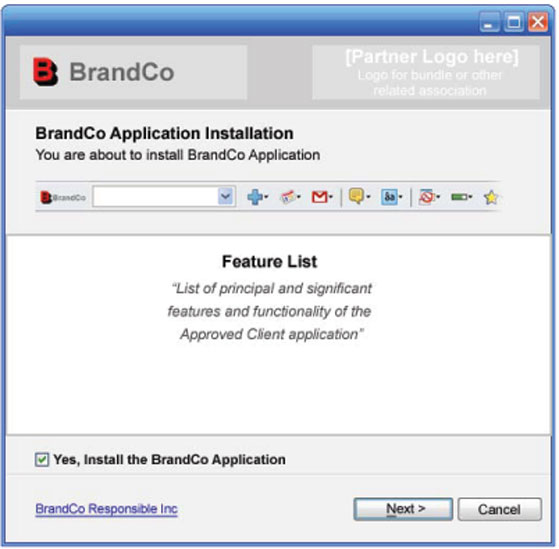
| 8 | Google Confidential |
Appendix B
Disclosure and Consent Requirements for Changes to an End User’s Default Search
Engine and/or Homepage
(Search-Based Approved Client Applications)
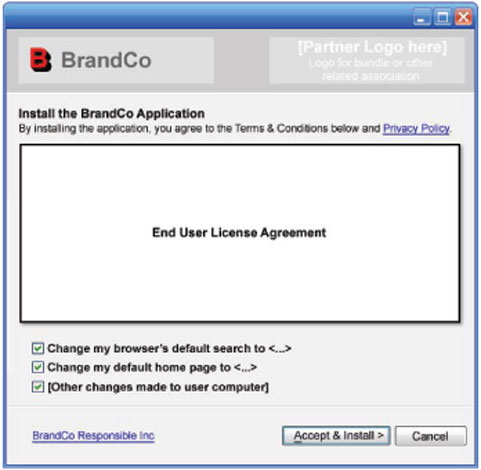
| 9 | Google Confidential |
Appendix C
Disclosure and Consent Requirements for Changes to an End User’s Default Search
Engine and/or Homepage
(Non-Search Based Approved Client Applications).
Affirmative Consent of End User is Required for Changes to Default Search
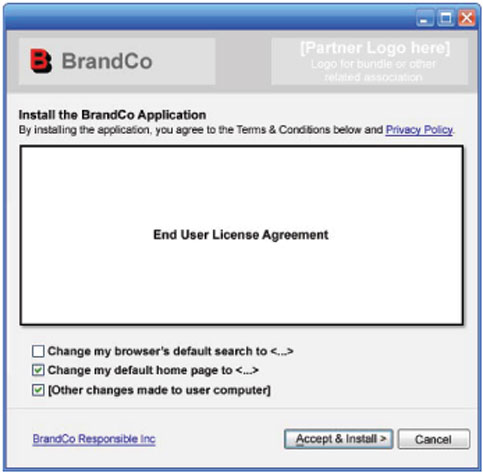
| 10 | Google Confidential |
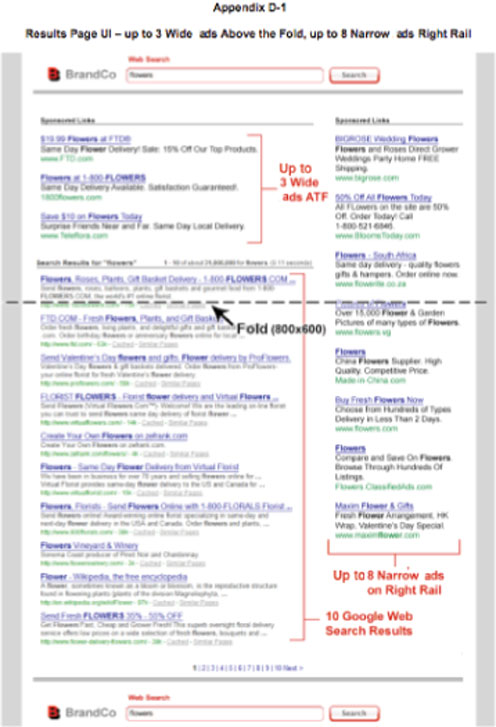
| 11 | Google Confidential |
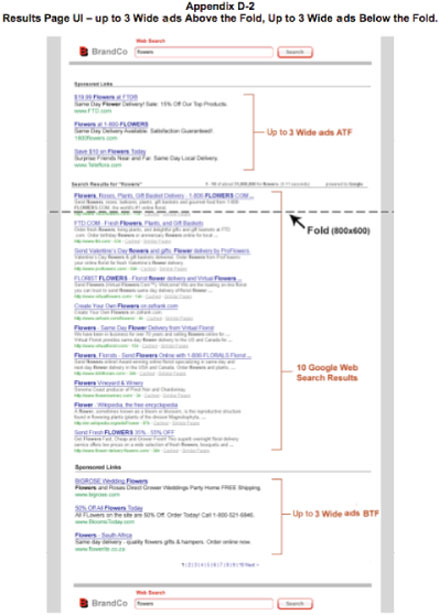
| 12 | Google Confidential |
Appendix E
Bundling of Applications
When bundling, the end user must be made aware of all the applications included prior to installation.
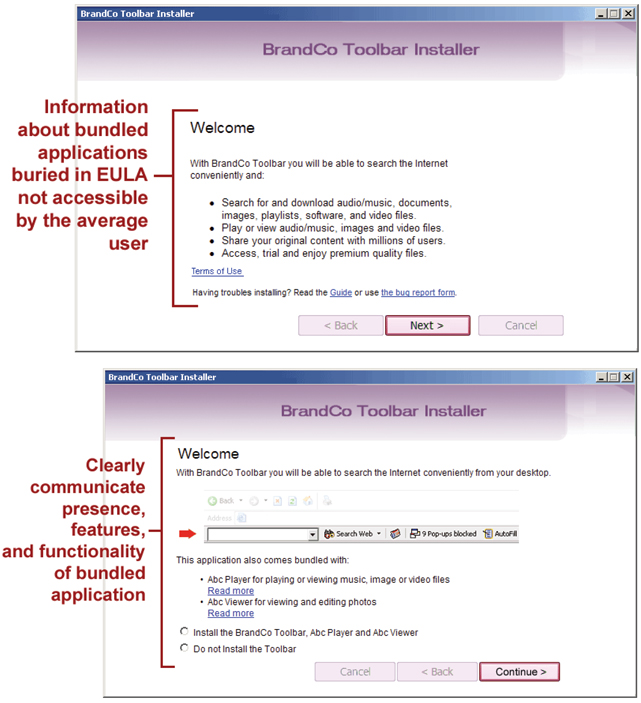
| 13 | Google Confidential |
Appendix E (continued)
When bundling, the end user must be made aware of advertising revenue relationships to other
applications, if the continued use of the primary application is conditioned on the other
applications being installed and active on the end user’s computer
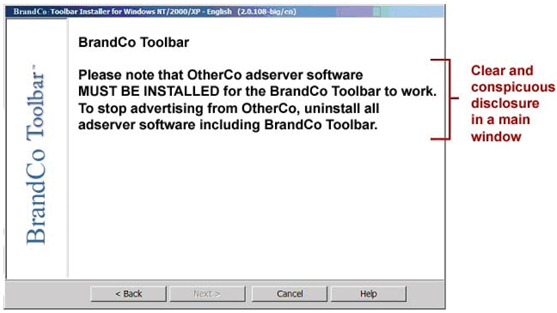
| 14 | Google Confidential |
Appendix F
Deactivation
The Application must permit end users to uninstall it in the customary place the applicable
operating system has designated for adding or removing programs (e.g., Add/Remove Programs
control panel in Windows) in a straightforward manner and must contain (in an easily found
location) clear and concise instructions on how it may be uninstalled
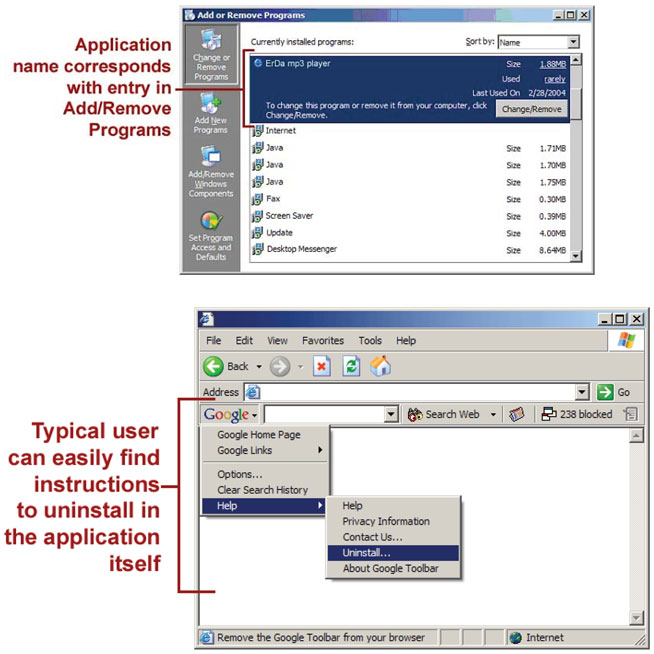
| 15 | Google Confidential |
Exhibit B
Mock up of a Site Homepage
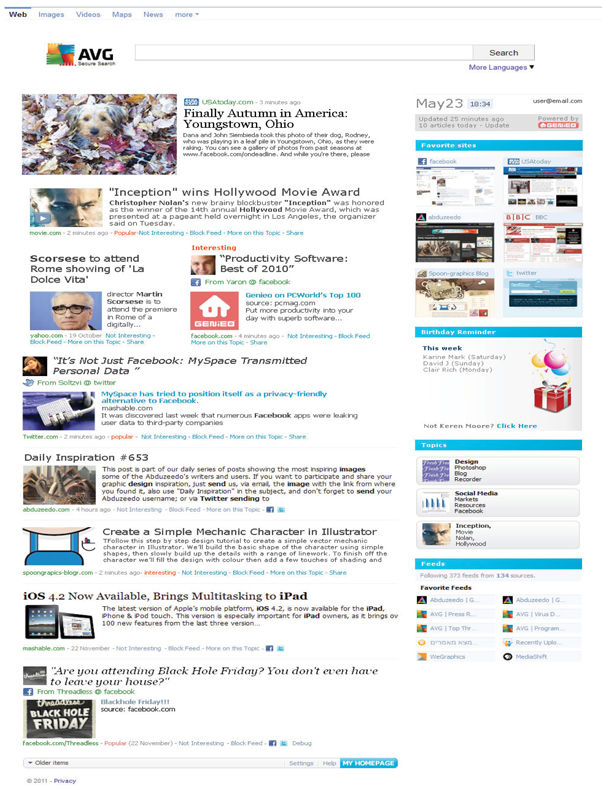
| 16 | Google Confidential |
Exhibit C
Novation Agreement
Google Ireland Limited
Xxxxxx Xxxxx
Xxxxxx Xxxxxx, Xxxxxx 0
Xxxxxxx
[DATE]
Dear Sirs,
Transfer of contract
We refer to the contract between you and us for Google Search and Advertising Services Agreement and Order Form dated 1 October 2010 (Contract).
We will transfer our business to [another company within our group,] [INCOMING PARTY] [on [DATE]]. As part of the business transfer, we wish to transfer all our rights, obligations and liabilities under the Contract to [INCOMING PARTY] on the terms set out below.
[INCOMING PARTY] is a company registered in England and Wales (registered number [NUMBER]) and its registered office is at [ADDRESS]. [PROVIDE FURTHER RELEVANT INFORMATION ABOUT THE INCOMING PARTY, FOR EXAMPLE, ITS REPUTATION, ITS PARENT COMPANY, IF APPLICABLE]
In consideration of each party to the Contract granting the releases and undertaking the obligations set out in this Transfer of Contract and in consideration of each party to the Contract paying to the [INCOMING PARTY] the sum of £1 (receipt of which is hereby acknowledged) each party agrees that with effect from [DATE]] (Effective Date):
| • | We transfer all our rights and obligations under the Contract to [INCOMING PARTY]. |
| • | [INCOMING PARTY] will perform the Contract and be bound by its terms in every way as if it were the original party to it in place of us. |
| • | You will perform the Contract and be bound by its terms in every way as if [INCOMING PARTY] were the original party to it in place of us. |
| • | Each of us releases the other from all its future obligations under the Contract. |
| • | Each of us release and discharge us from all claims and demands arising under or in connection with the Contract including without limitation claims for negligence and fraud, in each case whether known or unknown to you, except that nothing in this agreement shall affect or prejudice any claim or demand that either of us may have against the other that relates to matters arising before the Effective Date. |
AND
| 17 | Google Confidential |
| • | [INCOMING PARTY] agrees to indemnify us against any losses, damages or costs we suffer or incur under or in connection with the Contract as a result of its failure to perform or satisfy its assumed obligations under the Contract. |
AND
| • | We agree to indemnify [INCOMING PARTY] against any losses, damages or costs it suffers or incurs under or in connection with the Contract as a result of our failure to perform or satisfy our obligations under the Contract before the Effective Date. |
| • | The Contract will in all other respects continue on its existing terms. |
From the Effective Date, you should deal solely with [INCOMING PARTY] in respect of the Contract; all invoices and correspondence relating to the Contract should be sent to [INCOMING PARTY] at the address set out above, marked for the attention of [NAME OF INDIVIDUAL].
If you have any questions concerning the proposed transfer, please contact [NAME] on [TELEPHONE NUMBER] or at [E-MAIL ADDRESS].
This letter and any dispute or claim arising out of or in connection with it (including non-contractual disputes or claims) shall be governed by and construed in accordance with English law and the parties submit to the exclusive jurisdiction of the English courts.
Please sign and return the enclosed copy of this letter to acknowledge your agreement to the transfer of the Contract.
Yours faithfully,
[***]
for and on behalf of [OUTGOING PARTY]
We agree to the transfer of the Contract to [INCOMING PARTY] with effect from the Effective Date on the terms set out above.
Signed [***]
for and on behalf of [INCOMING PARTY]
Date
Signed [***]
for and on behalf of Google Ireland Limited
Date
| 18 | Google Confidential |
